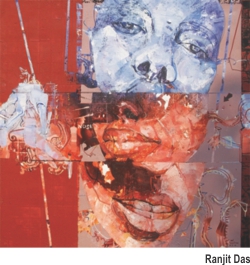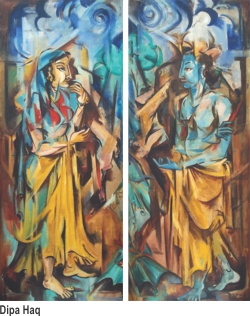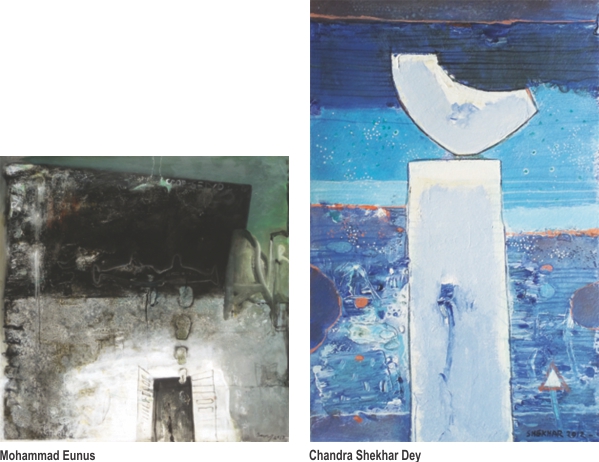| Home - Back Issues - The Team - Contact Us |
 |
| Volume 11 |Issue 50| December 21, 2012 | |
|
|
Exhibition BORN IN THE FIFTIES Felix Wilker
“When you look at the works of artists like Mohammad Eunus you can already see through the titles that his pieces are created in memory of 1971, the Liberation War”, Galleri Kaya director Goutam Chakraborty said at the exhibition's opening on Friday, December 14. “It is reflected through all of the artists' works, but in some cases it's a non-objective representation”, Chakraborty added. In Eunus' case his abstract expressionism frequently changes the arrangement of forms, compositions and the structure of paintings. Chandra Shekhar Dey is another artist who belongs to this generation of painters whose view on life and art was profoundly impacted by the War of Liberation. In his case, the war is a fundamental cause for the ardent outburst of colour in his paintings. The sharply contrasted use of light and shade bring about memories of loss and pain. He combines elements of folk, shreds of myth and vivid, interactive forms to bridge the gap between reality and fiction.
Artist Kazi Rakib, who was a messenger and assistant to the freedom fighters at only 16 years carrying arms and supplying food to the frontlines, said at the opening: “I cannot explain how it influences me, it's a feeling. Some of my friends died at that time, it's a very sad part of my life.” In his water colours he incorporates early life memories depicting the innocence of women and childhood friends from his village, an innocence which he hardly encountered in post-war times.
Different essences of nature, transformation, abstraction and the combination of prose and poetic forms dominate the works of painter Ranjit Das. His acrylics express beauty and colour in tradition of post-impressionist masters like Van Gogh and Matisse, while incorporating a contemporary, almost street-art-like style of painting. It might not be a coincidence that doves, well-known as a symbol for peace, are a recurring stylistic device in his works.
“Born in the Fifties” was inaugurated by former actress Sarah Begum Kabori, now Member of Parliament, and Yussuf Abdullah Harun, former president of the Federation of Bangladesh Chambers of Commerce and Industry (FBCCI), on Friday, December 14. The exhibition is well worth seeing as it shows the diverse identities, styles, and subjects of a group of artists, who share a common creative root in the nation's struggle for independence. “All of the artists have a very strong linguistic identity of their own, because they have already exercised almost forty years of their life in this field. But what brings them together is that they are born in the fifties”, gallery director Goutam Chakraborty said. “Born in the Fifties” will continue at Galleri Kaya in Uttara until December 25 and is open daily from 11am to 7.30pm.
Copyright
(R) thedailystar.net 2012 |
 A
A
 Another artist, whose works can be found at Galleri Kaya, is Dipa Haq, one of the country's first renowned female artists. Undoubtedly the largely male dominated art scene of post-war Bangladesh has been altered and enriched by the presence of such female artists like Haq. Before her early death in 1999, she compiled a rich, variegated body of work containing raw charcoal self portraits and surrealistic, exuberant pastel paintings of swirling forms and proud, spirited women. Due to these different styles the mood of her work ranges from graceful repose to tearing anxiety.
Another artist, whose works can be found at Galleri Kaya, is Dipa Haq, one of the country's first renowned female artists. Undoubtedly the largely male dominated art scene of post-war Bangladesh has been altered and enriched by the presence of such female artists like Haq. Before her early death in 1999, she compiled a rich, variegated body of work containing raw charcoal self portraits and surrealistic, exuberant pastel paintings of swirling forms and proud, spirited women. Due to these different styles the mood of her work ranges from graceful repose to tearing anxiety.